As a traveler, I realized some time ago that, in addition to our physical luggage we also carry a metaphorical suitcase filled with our life experiences. Part of my world view has been shaped not only by where I’ve lived most of my life but the idea that you come to a better sense of a place by traipsing through its streets, observing and interacting with its people, finding its oddities, and sometimes being exposed to some of the dark nooks of its history. This was the Vienna I set out to discover Saturday afternoon. The day’s perpetually gray skies seemed somewhat fitting for such an adventure.
Hoher Markt.
Here’s a good approximation of my afternoon walk courtesy of Google Maps. 
Leaving the tram not far from the Opera House, my first stop on my dark side tour was at Vienna’s Hoher Markt or High Market so named because of its importance not it’s location. This square is frequented by tourists and described by Vienna.info as, “One of the oldest and most historic squares in Vienna and home to the Anker Clock.”
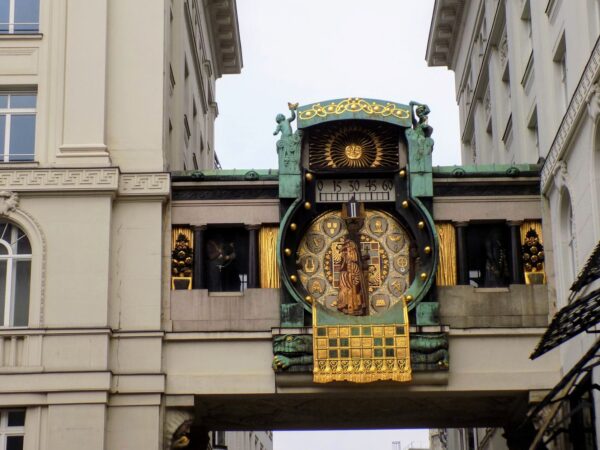
Anker Insurance Company installed the mechanical Art Nouveau Ankeruhr as part of their headquarters expansion in 1914. The company’s public intent was for the clock to be a contribution to the city’s art and culture. However, they also managed to have designer Franz Matsch incorporate representations of the transience of human life thereby providing a subliminal reminder that life insurance is important too.
The clock has figures representing life and death and has a dozen historical figures with each rotating hourly around the minutes of time. Appropriate organ music plays as each new figure appears and at noon all 12 complete a bonus rotation. This is the time of day when you’re likely to find hundreds staring up at the clock in anticipation.
I’m sure many are also drawn here by the Vermählungsbrunnen or wedding fountain.
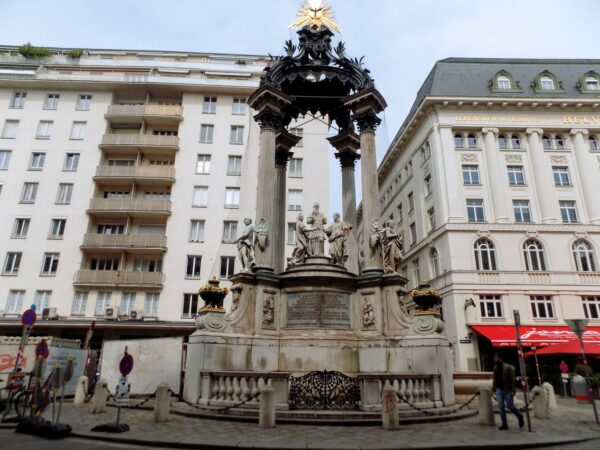
The monument we see today (sometimes called the marriage fountain) is a late nineteenth century restoration of the monument’s second iteration. It began as a votive column built when Emperor Leo the First promised to erect a monument on the site if his son and designated heir Joseph returned safely from the Siege of Landau in the War of Spanish Secession. Leo died in 1705 so Joseph completed the wooden monument in 1707. Karl VI replaced the original with a more permanent stone monument some 25 years later.
The improved monument bears Corinthian columns made of white marble with the allegorical figures of Humility on the right and Purity on the left. Its name derives from the two small sets of fountains that flank the columns and its central scene that depicts the marriage of Joseph and Mary.
What few people who admire the monument know is that it stands on the site of the gallows and pillory that Joseph had to remove before constructing it. There’s no record of the number executed before the monument’s erection.
(Film noir buffs might recognize the Vermählungsbrunnen from it’s appearances in The Third Man.)
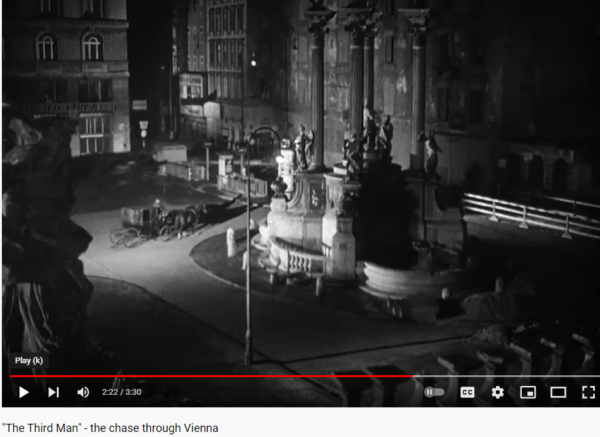
[Screenshot from YouTube.]
Theresia Kandl.
Paraphrasing a Russian proverb popularized by a past American president, “Believe, but verify.” Regarding travel, I apply this axiom to guide books, web sites, local tour guides, or any other source of information. So while I can’t guarantee that all the information I report in this blog is entirely accurate, I can assure the reader I’ve confirmed the information I include with more than one source. Such is the case with the story of Theresia Kandl.
I was led to the Hoher Markt by the contents of this article that, in this instance was true but insufficiently researched. The article claimed that it was here in 1809 that the young Missus Kandl became the first woman hanged in Vienna after being convicted of murdering her husband in a gruesome manner.
I believed it initially but then I ran headlong into the troublesome fact that Joseph had dismantled the Hoher Mark gallows more than a century earlier to erect the original votive monument. A deeper probe convinced me that Hoher Markt had once been the site of the gallows and that as far as any records showed Theresia Kandl was indeed the first woman hanged in Vienna but her execution didn’t occur there. Most sources agree that, prior to her execution, she spent time in a pillory. However, some place that event at Hoher Markt while others put it a short distance away at Graben. Still, I found her story fascinating and cautionary. A tale that is, in some ways, remarkably relevant today.
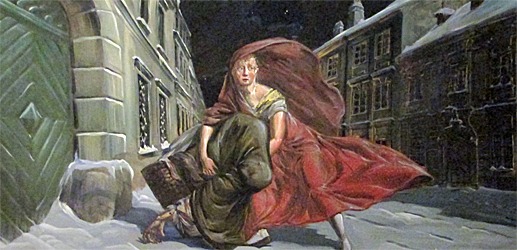
[Painting of Theresia Kandl fom the Vienna Criminal Museum].
Theresia Töbich, also called Resi, was 23 years old when she married Matthias Kandl. Apparently, Matthias, who was much older than she, was an alcoholic who repeatedly physically abused the young and lively Resi. When he came home drunk on the night of 19 December 1808 and began threatening her, Theresia snapped. She brought a pick or an axe from the basement and, in a fit of rage, smashed-in her sleeping husband’s skull striking him repeatedly. According to the post-mortem, the surgeon found “no fewer than ten wounds, some fatal, some minor.”
Resi was a small woman and according to the notes of her interrogator, she was quite attractive. He wrote, “She has a slim build, a long, clean face, a beautiful nose, imperial blue eyes, and blonde hair that is pulled back into a chignon.” It’s somewhat ironic that after she put her husband’s remains in a bag or basket of some sort, a local police officer saw a pretty young woman struggling to carry the large parcel (Matthias reportedly weighed more than 100 kilograms) slung over her back through the snow. He stopped and lifted it back in place before going on his way. Exhausted after toting the body more than three kilometers, she simply dropped Matthias into the snow in the Piaristengasse and returned home.
After the body was discovered, the police came to the Kandl home to investigate and initially, Theresia convinced them of her innocence. However, Resi was apparently having an extramarital dalliance with a young fellow named Michael Pellmann and a neighboring baker who, according to some, was jealous of the butcher’s son, reported some suspicions to the police. A second search discovered the blood spattered murder weapon.
Arrested and confronted, Theresia eventually confessed and was sentenced to be hanged. Three days before her scheduled execution she was taken either to Hoher Markt or Graben and placed in a pillory that might have looked something like this:
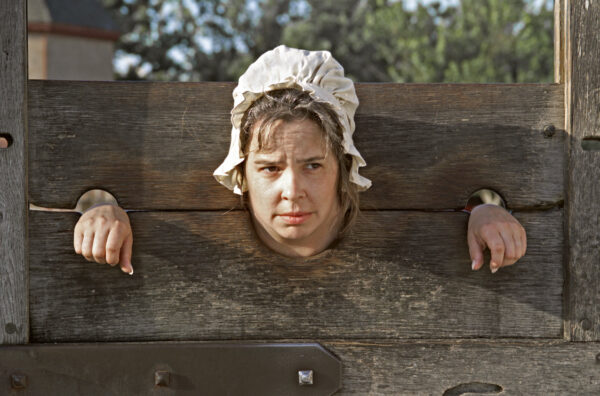
Punishment: Karen Clancey Steve Hollaway 2001 CWJ. Photo By David M Doody.
Again, there are conflicting reports about Theresia’s treatment while in the pillory but there’s little doubt that the Viennese turned out by the thousands to, at the very least, gawk in astonishment at the pretty, petite young woman who had committed such a brutal act. Anton Ferdinand von Geusau noted in his 1809 Historical Diary, “Since no woman had ever been hanged in Vienna, the influx of people was indescribable!” Over the three days, scores of so-called murder ballads were spontaneously composed and sung.
Reportedly, a vehicle accompanied by three hundred and thirty-two cavalry and infantrymen and thousands of Viennese left the central city early on the morning of 16 March. Theresia Kandl reached the new gallows at 10:00 at Spinnerin am Kreuz where she became the first – and possibly only – woman ever executed in Vienna. (Ninety years later, Juliana Hummel was found guilty of the severe abuse and murder of her daughter Anna. Juliana died in prison. Her cause of death is unclear.)
But the world wasn’t quite done with Theresia Kandl.
Within days of her death, Resi’s body was exhumed for study. It somehow found its way to a pastor in Engelhartstetten and, when his estate was sent to auction after his death, a doctor, Franz Hollstein, purchased her skeleton for 60 guilders. It was stored first in an attic on his property then moved to a shed when a teacher named Friedrich Dallinger bought the house. From there her remains went to the Lower Austrian State Museum which loaned them to the Vienna Criminal Museum where they are currently on view.
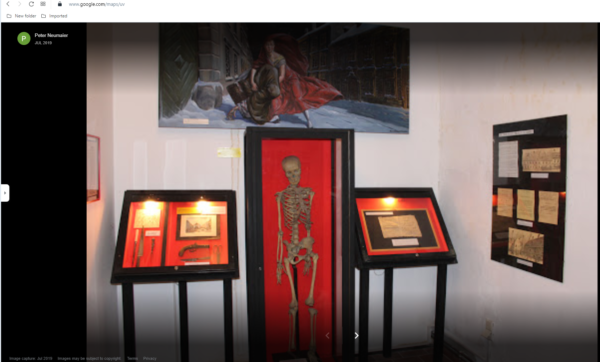
[Screen capture from Google Maps].
And one last thing.
The Viennese weren’t completely done with Resi Kandl either. Somehow, perhaps because she’d been so badly abused, she became something of a folk heroine and, in her memory, a chapel was built in her hometown of Atzgersdorf that’s now a part of Vienna.
The chapel, built in the late classical style with a triangular floor plan intended to evoke the Trinity, originally stood on the corner of Breitenfurter Straße and Hödlgasse. It drew so much attention, however, that it became a traffic choke point. In 1963 it was relocated and is now integrated into the fencing of the Vienna South campsite.

[Theresia Kandl Chapel from Wikimedia Commons Thomas-Ledl-Own-work-CC-BY-SA-3.0].
Perhaps we’ve reached the end of Theresia’s story but we’ll discover more of Vienna’s dark side in the next post.